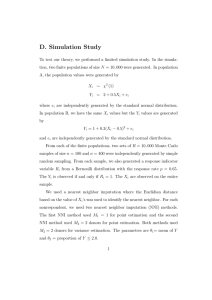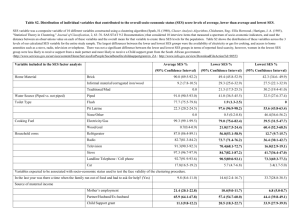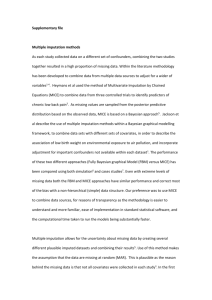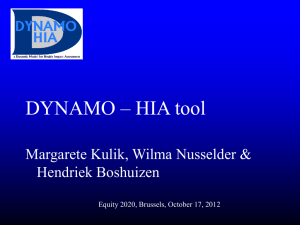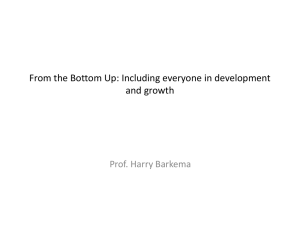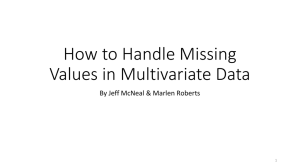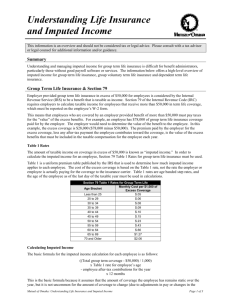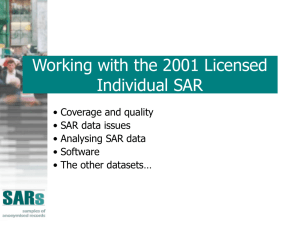Technical Appendix - Durham University Community
advertisement
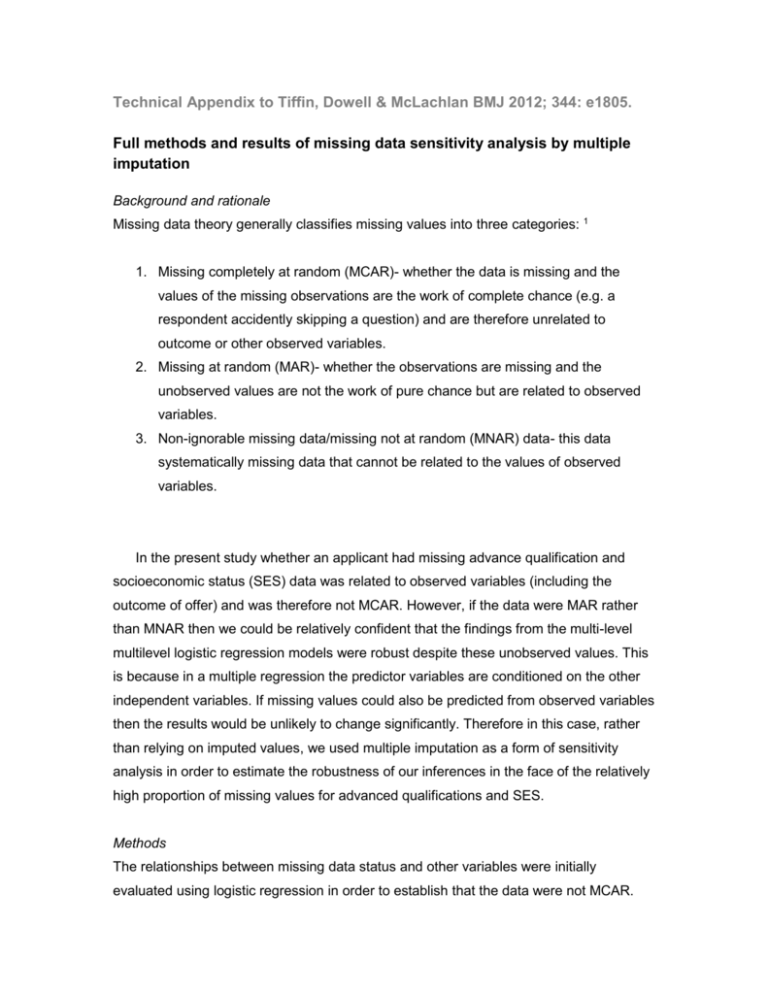
Technical Appendix to Tiffin, Dowell & McLachlan BMJ 2012; 344: e1805. Full methods and results of missing data sensitivity analysis by multiple imputation Background and rationale Missing data theory generally classifies missing values into three categories: 1 1. Missing completely at random (MCAR)- whether the data is missing and the values of the missing observations are the work of complete chance (e.g. a respondent accidently skipping a question) and are therefore unrelated to outcome or other observed variables. 2. Missing at random (MAR)- whether the observations are missing and the unobserved values are not the work of pure chance but are related to observed variables. 3. Non-ignorable missing data/missing not at random (MNAR) data- this data systematically missing data that cannot be related to the values of observed variables. In the present study whether an applicant had missing advance qualification and socioeconomic status (SES) data was related to observed variables (including the outcome of offer) and was therefore not MCAR. However, if the data were MAR rather than MNAR then we could be relatively confident that the findings from the multi-level multilevel logistic regression models were robust despite these unobserved values. This is because in a multiple regression the predictor variables are conditioned on the other independent variables. If missing values could also be predicted from observed variables then the results would be unlikely to change significantly. Therefore in this case, rather than relying on imputed values, we used multiple imputation as a form of sensitivity analysis in order to estimate the robustness of our inferences in the face of the relatively high proportion of missing values for advanced qualifications and SES. Methods The relationships between missing data status and other variables were initially evaluated using logistic regression in order to establish that the data were not MCAR. Therefore in order to estimate the extent to which these missing data could be considered MAR a series of sensitivity analyses were performed using multiple imputation procedures. 2 For the SES data ten imputed data sets were produced. A univariate imputation procedure was utilised whereby the dichotomous imputed values (low SES present or absent) were conditioned, via a logistic regression, on the observed predictor variables. Advanced qualification data was excluded from this missing data modelling as in around 10% of cases candidates were missing both information SES and advanced qualifications. Thus, this would have led to an inability to impute SES values for this minority of candidates. Whilst imputation procedures can be used to emulate clustering in multilevel models this was unnecessary in this case as the variables to be imputed (SES and advanced qualifications) were missing at the individual level. Consequently, missing SES categories could be imputed for 4,346 candidates. Only values relating to 259 candidates could not be imputed due to missing values on one or more other sociodemographic variables (aside from advanced qualifications). Similarly for the missing advanced qualification data ten imputed data sets were created. Again, a univariate imputation procedure was used though this time the imputed values (standardised UCAS tariff scores) were treated as continues and condition via a linear regression on the observed predictor variables (with the exception of SES, again due to the high rate of missingness). In order to allow for the censored nature of these standardised UCAS tariffs (i.e. no candidate could obtain more than around 1.27 standard deviations above the mean as only the grades from best of three or equivalent A levels were counted) imputed values above 1.27 were replaced with the theoretical maximum standardised tariff observable. Values could be imputed for 4,729 candidates where advanced qualification data had been missing. Imputed values for 188 candidates could not be generated due to missing predictor variables required for the missing data modelling. Results As expected, the imputed datasets contained higher rates of low academic achievement and low SES than observed in the non-imputed data. As the data relating to applications contained higher rates of missingness compared to that related to entrants the multilevel logistic regression analyses relating to obtaining conditional and unconditional offers were repeated using the multiply imputed data sets, with results being pooled. The results from the analysis of the imputed datasets were generally very similar to those relating to the original, non-imputed data. For the data with missing SES categories imputed the ORs obtained for the probability of obtaining a conditional offer only differed by an average of 8% (range 1% to 25%) from those originally obtained. For three interaction terms the status of the statistical significance of the coefficient changed; the interaction between an application to a Group 2 (compared to a Group 3) university and ethnicity became statistically significant (p=.01) whilst the interaction between a Group 1 application (compared to Group 3) and SES become non-significant (p=.1), as did the interaction term between UKCAT score and ethnicity (p=.06). For the model relating to unconditional offers the OR obtained differed by an average of 5% (range 0% to 10%) from those originally obtained. For two predictor variables the status of the statistical significance of the coefficient changed; SES became a predictor variable of only borderline significance (p=.08) whilst EASL became statistically significant (p=.02). For the data with missing advanced qualification attainment imputed the ORs obtained for the probability of obtaining a conditional offer differed by an average of 12% (range 0% to 45%) from those originally obtained. Those coefficients for age of applicant and EASL status became statistically significant (p=.002 and p<.001 respectively). Those coefficients relating to the group of university group applied to also changed in significance (Group 1 became non-significant (p=.1) whilst Group 2 became significant (p=.03). For three interaction terms the status of the statistical significance of the coefficient also changed; the interaction between an application to a Group 1 (compared to a Group 3) and SES became of borderline significance (p=.06) whilst the interaction terms between UKCAT score and age of applicant became non-significant (p=.4) as did the interaction term between UKCAT score and ethnicity (p=.7). The ORs obtained for the probability of obtaining an unconditional offer differed by an average of 9% (range 1% to 26%) from those originally obtained. The coefficients for age of applicant (p=.2) and SES became non-significant (p=.1) whilst EASL status became statistically significant (p<.001). In addition the interaction term between an application to a Group 1 (compared to Group 3) university and UKCAT score became non-significant (p=.9). Conclusions Overall the results from the analysis of the imputed data sets differed relatively little from those relating to the non-imputed data, with an average of around 5-10% variation in the ORs recovered for the predictor variables. This implies that the missing values were likely to be generally MAR. However, in a small minority of cases the coefficients (and hence ORs) for independent variables and interaction terms did change in statistical significance status and therefore it may that at least some of the missing data are nonignorable. This could be possibly related to a subgroup of applicants (e.g. mature applicants) where missing values are may not be so closely related to observed covariates and outcomes. Overall the results suggest we should be relatively confident about our findings relating to offer. However, some caution may be required when specifically considering the impact of the missing advanced qualification values on the ability to model the probability of conditional offers. References 1. Rubin DB. Inference and missing data. Biometrika 1976;63:581-92. 2. Verbeke G, Molenberghs G, Thijs H, Lesaffre E, Kenward MG. Sensitivity analysis for non-random dropout: a local influence approach. Biometrics 2001;57:7-14.

